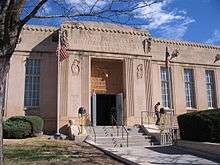Panhandle–Plains Historical Museum
 | |
 | |
| Established | April 14, 1933 |
|---|---|
| Location |
2503 4th Avenue Canyon, Texas 79015 |
| Coordinates | 34°58′49″N 101°55′02″W / 34.980327°N 101.917257°W |
| Visitors | 52,000 (2013) |
| Founder | Panhandle-Plains Historical Society |
| Director | Guy C. Vanderpool |
| Curator |
Michael R. Grauer Becky Livingston Veronica Arias |
| Website |
panhandleplains |

Panhandle–Plains Historical Museum is a history museum on the campus of West Texas A&M University in Canyon, Texas, U.S.A., a small city south of Amarillo. The museum's contents are owned and controlled by the Panhandle-Plains Historical Society, while West Texas A&M University and the Texas A&M University Board of Regents maintains and provides the facilities. Panhandle–Plains Historical Museum claims to be the largest history museum in the state of Texas with 70,000 visitors annually and more than three million artifacts.
The museum's permanent exhibits include American Western life and agriculture history artifacts, art, paleontology, geology, Native American art and artifacts, firearms, antique vehicles, decorative arts and furniture, petroleum industry artifacts, sports artifacts, and textiles. The museum also features the outdoor Pioneer Town that includes a livery, saloon, schoolhouse, pioneer cabin and other buildings.[1]
The Panhandle-Plains Historical Society was founded in 1921 by faculty and students of West Texas State Teachers College and area supporters to preserve the history of pioneer life and natural history in the West Texas region. The museum received financial assistance from the Commission of Control for the 1936 Texas Centennial.[2] The museum opened its permanent and present location on April 14, 1933.
Timothy Dwight Hobart of Pampa, a well-known land surveyor originally from Vermont, was elected president of the society in 1927 and served for six years. He pushed for completion of the museum. In 1933, he became an honorary board member for life.[3]
The noted historian Angie Debo served as curator of the museum from 1933 to 1934.
In 2001, the museum underwent a $5.8 million renovation.
Some of the permanent exhibits include "People of the Plains: Experiments in Living", displays the difference and similarities of past and present Southern Plains settlers; "Pioneer Town", a recreation of a small settlement in the Texas Panhandle in the early 1900s; "The Don D. Harrington Petroleum Wing", a two floor exhibit showing the Texas Panhandle's oil boom years in the 1920s and 1930s; and "The T-Anchor Ranch House", an exhibit outside of the museum which recreates the original house that was constructed in the late 1870s.
From 1951 until his death in 1963, Western artist Harold Dow Bugbee was curator of the museum. In 1990, the museum opened a replica of Bugbee's art studio. On the death of Olive Vandruff Bugbee in 2003, the museum inherited the couple's $1 million estate. The museum also houses much of the western art collection of Frank Reaugh (1860-1945), who stressed pastoral harmony in nature in his paintings.
Texas State Senator Grady Hazlewood of Amarillo, who served from 1941-1971, helped to procure state funding of the museum and contributed $20,000 of his own money for the establishment of the archives section, which houses his own papers.[4]
| Statue of legendary cattleman Charles Goodnight outside the Panhandle-Plains Historical Museum in Canyon. |
Chuckwagon exhibit at Panhandle-Plains Museum |
Campfire biscuits at the Panhandle-Plains Museum |
A 1920s vehicle is parked outside a motel at the Panhandle-Plains Museum. |
Turn-of-the-century bicycle at Panhandle-Plains Museum |
References
- ↑ http://www.panhandleplains.org/collections/perm-pioneer.html Pioneer Town
- ↑ "TEXAS CENTENNIAL". The Handbook of Texas. Texas State Historical Association. Retrieved 1 December 2013.
- ↑ Lester Fields Sheffy, The Life and Times of Timothy Dwight Hobart, 1855-1935: Colonization of West Texas (Panhandle-Plains Historical Society, 1950), p. 283.
- ↑ "Robyn Followwill-Line, "Grady Hazlewood"". Amarillo Globe News, May 19, 2000. Retrieved April 17, 2010.
- Panhandle-Plains Historical Museum from the Handbook of Texas Online.
- Texas A&M University System. "Panhandle Plains Historical Museum: Still the state's largest". Retrieved 2006-04-07.